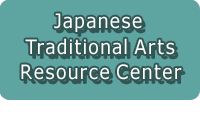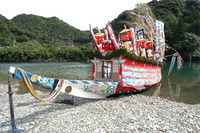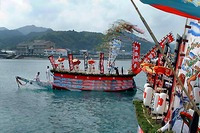

Total:35items
- Folk Performing Art (16)
- Kabuki (2)
- Noh & Kyogen (1)
- Festival (10)
- Wakubata woolen banner event of Kumakabuto Hatsuka Festival
- Hakone Feudal Lord's Procession Festival
- Uozu’s Tatemon Event
- Yama-age Event (Yama-age Festival)
- Yoshidanohimatsuri: Fire Festival of Yoshida
- Potato-comparing Festival in Nakayama, Oumi
- Noto's Kiriko Festival
- Ara-odori (Sankasho Shrine Festival)
- Mi-fune event in Kouchi Festival
- Nozawa Onsen Dosojin Festival
- Ritual & Ceremony (2)
- Puppet Play (2)
- Folk technology (2)

 |
|
 《Feature》
《Feature》What is "Kouchi Matsuri?"
Kouchi Matsuri is a traditional festival organized by five districts located along Koza River, Koza,Furuta, Takaike, Utsugi, and Tsukinose. The festival was so well-known from old times that it was written as "No other festival in the area between Hiokeura and Shingu is worth seeing than Kouchi Festival" in "Kii Zoku Fudoki (the second edition of geographical records of southern part of Kii peninsula including local events and custom compiled in 1839 ).
The main industry in Koza situated at the mouth of a river is fishery and the people in the other districts have built their own communities through forestry for many years. No other festival can be seen in Japan like Kochi festival where people from different areas gather at Kouchi Shrine once a year and each area holds a festival simultaneously in each own characteristic way.
(What is Kouchi sama?)
The deity worshipped in Kouchi shrine is called "Kouchi sama (people in this area pronounce "Kottama"), which is a small granite island. The shrine keeps primitive style of nature worship, which does not have a prayer hall.There is a holy stone in the center of the wood on the island. And when "Mifune","Tofune" and "Shishi denma", three boats which play the leading roles in the festival, arrive at "Kottama" (the island), the captain of each boat steps on the island and pours holy sea water and libation to the holy stone, and prays to the god. The god of the shrine is said to be "Susano-no-mikoto", one of the God in the Japanese myth. In the past, it was believed that a foreign god, "Gozu tenno" who was an incarnation of Healing Buddha was worshiped together with "Susanoo no mikoto" in Kouchi shrine. Some experts indicate that the festival was conneted with "Gion-e", a famous festival in Kyoto originated in a ritual to stop the plague spread. It is said that during the wartime, soldiers who were leaving their hometown for the battle fields picked up stones on the riverside where festival was held and carried with them as talisman. It is believed that spiritual power exists in the stones. Whatever the truth is, it may be good that "Kottama" is a great god worshipped by all the people living near the sea and the mountain.
(What is "Shouro"?)
Every year, one school girl and two school boys in Koza district are chosen to play roles of "Shouro", living Gods in the festival.
The children had to stay in the shrine till they finished their roles in order to stay away from impurities. They were not even allowed to put their feet on the unclean ground. (But it has changed from a few years ago so children do not have to stay in the shrine any more.) On the festival day, "Shouro" children wearing Chigo costumes get on "Tofune boat" (a kind of boat for a person of high position) with Shinto priests, and during the ritual, they sit on the special seats set on the riverside while people pray at them.
The seats of "Shouro" set on the riverside turn toward Kuroshima island. There are various opinions about why they don't turn toward "Kochi Island" which is the deity of the festival. Meanwhile, in other district, like southern part of Takaike district, one old woman and a boy and a girl are chosen to "Ohisashigando, who are worshipped in the festival. They do not wear special costumes except straw sandals. And unlike "Shoro" children in Koza area, "Ohisashigando" sit on the seat turning toward "Kochi sama"and they don't receive any prayers from people during the ritual.
(Kochi sama is a festival for women)
In the festival, men take almost all responsibilities except particular roles such as "Shoro", and "Tengu"dance participated by women. Women are just lucky enough to enjoy watching the festival as an audience in Yakata-bune (houseboat). This is why "Kouchi sama" is called a festival for women. And it was also men's responsibility to help the houseboats pass through the river; they wait for the boats when they comes to a dangerous spot just before Kauchisama, called "Rokujyo Rapids" (which means six snakes in the river in Japanese). The rapids also often took an important role of a meeting place for young men and women.
(Fun of Kouchi festival)
○Cozy "Yakata bune"
One of the enjoyments in "Kouchi festival" is "watching from the houseboat". In old days, river boat was the main transportation in Kozagawa area, which enabled people in the area to enjoy the festival with their relatives in a houseboat chartered or paid themselves. Now as the roads were well-paved and many people come to see the festival by cars, number of boats has completely decreased. However, more credit should be given to the luxury to eat and drink on the water while other people stay on a hot riverside under a blazing sun. Kouchi festival is also known for the event where people who are unknown each other splash water mutually.
○Kashiwa sushi
There are some unique cuisines in Kouchi festival.
In southern area of Takaike town, local foods such as Kashiwa sushi, shrimp, fava beans, horse radish salad and grilled flying fish are served at the meeting called "Naorai" held after all the events finished. Especially, Kashiwa sushi is the most common in the areas along Koza River.
Kashiwa sushi is similar to Gomoku sushi (sushi rice with cooked vegetables) called "Omaze" in the areas which is made into bite-size and wrapped with oak leaves. This is very tasty. We can bring it with us anywhere, and also it's appearance is very nice, different from"Kakinoha sushi" and "Mebari sushi
Kashiwa (Oak) leaves have preservative and prevents the rice from being sticky. Moreover, Kashiwa leaf's fine character is its pleasant smell. Is it Kashiwa sushi that will become popular next in Japan?
(A National Significant Intangible Folk Cultural Property)
Information provided by : Koza Youth Association
Translation: Naoko Yamashita, reviewed by Hiroko Okamura
| City/Town | 5 areas in Kozagawa city (Koza, Furuta, Takaike, Utsugi, Tsukinose area) |
|---|---|
| Location | (Kochi shrine)
171 Utsugi, Kozagawa town, Higashitoi-Gun, Wakayama Prefecture Tel: 0735-72-0589 (Japanese only) |
| Highlight/POI | Three decorative whaling boats likened as warships move up the river of Koza where whaling used to prosper in Edo era.
The main venue of the festival is a small island located three kilometer upstream of the river. The island is called "Kottama" where the Deity of "Kochi shrine" used to be enshrined. Now the Deity is kept in Koza shrine located on the mouth of the river. At the time of the festival, "Mifune" (the boat of the Deity) is decorated with "Shingaku (a frame carrying the name of the shrine) and sails to the island. Koza style Shishimai (Lion dance) which is said to be an origin of lion dance in Kumano area and boat race called "Kaidemma" is also worth seeing in the festival. Mifune event and Koza style lion dance performed by Koza youth association is designated to Significant Intangible Folk Cultural Asset by Agency for Cultural Affairs. |
| General Participation | (Event can be seen )
Mifune event in Kouchi Festival Place : Kochi Shrine Date : Every July 24th (Eve of the festival) 25th (Main festival) Assistance needed? For inquiries in English: JTCO Contact Form Your inquiries will be forwarded by JTCO in Japanese to the organization you wish to contact. |
| URL | http://www.kushimoto.jp/kozajisi/index.html |



